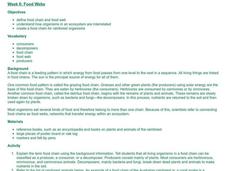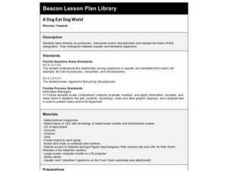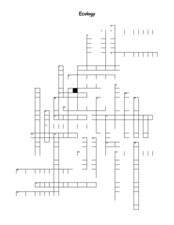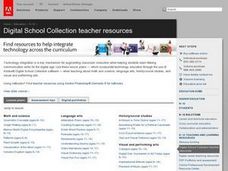Curated OER
Who Is Eating Whom?
Students discuss the food chain and identify if various organisms are producers or consumers. They draw ten types of organisms and construct a food web of these organisms, labelling each as a producer or consumer.
Curated OER
Food Webs
Students research rainforest animals and use that information to make a flow chart to show the order in which energy is transferred through several organisms. They label the producers, consumers, and decomposers in their chart.
Curated OER
Prior Knowledge Investigation-Food Webs
Students explore food webs. They identify any misconceptions of producers, consumers or decomposers and their relationship within a food web. Students draw an example of a food web for each of the examples that are given. They address...
Curated OER
Forest Appreciation
Learners gain appreciation for the value of the forest. In this forest lesson, young scholars discuss the benefits of forests and their products. They play a kinesthetic game about the consumers of the forest.
Curated OER
Lemonade Stand
Students plan a lemonade stand to compete with another stand and examine their decisions from the consumer and producer's point of view. They discuss the law of supply and demand, plan for their lemonade stand, and write an essay...
Curated OER
Getting to Know the Products from Trees
In this tree products lesson, young scholars read the book Tell Me,Tree: All About Trees for Kids, discuss how people make products from wood, define producers and consumers and then go on a treasure hunt for wood products at home and...
Curated OER
A Dog Eat Dog World
Fourth graders distinguish between acquatic and terrestrial organisms. They label animals as producers, consumers, and/or decomposers.
Curated OER
Insect Travel Brochure
Seventh graders study producers and consumers in habitats. They examine the trophic levels and how different organisms interact with a focus on insects. They create a travel brochure for an insect to visit a habitat which they create.
Curated OER
Southeast Asia And Globalization
Students investigate the area of Southeast Asia and how its economy has become the power that it is today. The concepts related to being a consumer are discussed. They go over how globalization has been introduced into Asia and helped...
Curated OER
The Flow of Energy Song
Students perform the lyrics and instrumental parts for the "Flow of Energy song." They create photo images which represent consumers, producers, decomposers, and scavengers. These images will be inserted in an iMovie of the class...
Curated OER
Needs and Wants
Students demonstrate responsible consumer choices. In this social studies instructional activity, students read The Lorax and discuss wants and needs. Students discuss how to save natural resources by making informed consumer choices.
Curated OER
Science: Pigments and Photosynthesis
Young scholars explore the process of photosynthesis by identifying chloroplasts and chlorophyll pigments. In a demonstration, they observe a demonstration connecting pigments with sunlight conversion into energy. Using paper...
Curated OER
Flow of Energy Through An Ecosystem
In this flow of energy in an ecosystem, students complete a graphic organizer and show the flow of energy from the sun to producers, primary consumers, secondary consumers, tertiary consumers and then decomposers. Students define each of...
Curated OER
Ecology
In this ecology activity, 6th graders will review ecology vocabulary words by circling the word that doesn't belong in each group of words for 6 questions. Then students will determine if 9 statements relating to animal and plant roles...
Virginia Department of Education
Freshwater Food Chains
What's in the water? Encourage your class to further explore this question and learn about pond ecosystems, food chains, and food webs as they complete this hands-on activity. They view the environment from a new perspective after...
Curated OER
What is an Ecological Footprint?
Introduce youngsters to the term ecological footprint. Learners identify ways in which humans affect the environment. They look at the problems associated with the use of natural resources, and focus on ways to preserve natural...
Curated OER
Mangrove Ecosystem
Eager ecologists explore ecosystems through video and photographs of a Mangrove. They discuss the animals in this habitat and how they interact with each other after reading and discussing "The Sea, the Storm and the Mangrove Tangle."...
Virginia Department of Education
Photosynthesis and Cellular Respiration
Provide high schoolers with their own indoor gardens! Emerging scientists discuss the process of photosynthesis and germinate seeds before growing plants in multiple lighting conditions. The hands-on application allows pupils to see...
Curated OER
Where Did Foods Originate? (Foods of the New World and Old World)
What do papayas, peanuts, pineapples, and potatoes have in common? Why, they are foods explorers brought back to the Old World. Young researchers use the Internet to investigate how New World explorers helped change the Old World's diet....
Curated OER
An Introduction to Modern Economics
Practice reading comprehension with this informational economics worksheet. Learners read a 2-page explanation of the beginnings of modern economics and how it plays a role in society. This reading discusses natural, human and capital...
Curated OER
Campaign Ads That Subtract and Add
Students explore media and media misrepresentation of prodcts. They create a video of a person (with both good and bad pictures.) Using creative titles, students download a slideshow. They add sound effects and other Adobe Premiere...
Curated OER
Economics: People as Producers and Consumers
Students examine the dual roles of producers and consumers in people by creating fictional stories that include examples of both. Their stories include descriptions of the tools and skills needed for the jobs of their characters and...
Curated OER
Label Language
Fourth graders explore food labels. In this consumer education instructional activity, 4th graders describe and evaluate various components of familiar food labels. Students discuss which traits make a product appealing to consumers....
Curated OER
Ecology: The Food Web
In this ecology instructional activity, students match the vocabulary to the definitions, then represent producers and consumers by drawing a Pyramid of Numbers.
Other popular searches
- Family and Consumer Sciences
- Family Consumer Science
- Consumer Science Foods
- Consumer Science Manners
- Health and Consumer Science
- Consumer Science Fibers
- Consumer Science Fibres
- Fm & Consumer Science
- Family & Consumer Sciences
- Consumer Science Fib Res
- Consumer Science Careers
- Food and Consumer Sciences

























